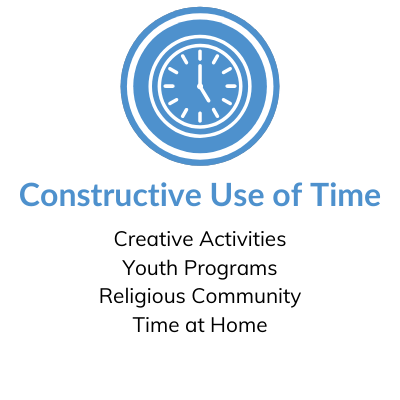Developmental Asset Categories
External Assets: Support | Empowerment | Boundaries & Expectations | Constructive Use of Time
Internal Assets: Commitment to Learning | Positive Values | Social Competencies | Positive Identity
External Assets: Support | Empowerment | Boundaries & Expectations | Constructive Use of Time
Internal Assets: Commitment to Learning | Positive Values | Social Competencies | Positive Identity
The rhythm of our lives seems to vary according to the activities in which we are in the moment. These fluctuations are normal and healthy. While young people may not have much to do or not enough to do consistently, they are right where they need to be. Problems arise when the balance begins to turn much more to one side than the other. Too much participation can lead to stress or anxiety. Too little participation can be a sign of depression or isolation. As adults who care about young people, it is our duty to ensure that young people use their time constructively for both fun and learning. Constructive Use of Time is one of the eight asset categories that make up Search Institute’s 40 Developmental Assets, the qualities, experiences, and relationships that help young people grow up healthy, caring and responsible.
Research shows that young people are more likely to grow up healthy when they have opportunities to learn new skills and interests through both structured and unstructured activities. The Search Institute has identified four key elements in the Constructive Use of Time category that are crucial in helping young people grow healthy: Creative Activities, Youth Programs, Religious Community and Time at Home.

Share your ideas for building these assets using @ShelteringWings and #SW40Assets.
Young people need opportunities—outside of school—to learn and develop new skills and interests with other youth and adults.
 The arts as fun and learning.
The arts as fun and learning.Whether it’s Mozart, the Rolling Stones or Tim McGraw, most of us like music of one kind or the other. We also like art. Being creative — singing, playing the piano, drawing, or acting — should be fun. But there’s more to it. The arts also help young people improve their basic and advanced thinking skills. Executing and creating works of art, even when far from perfection, help young people develop cognition (intellectual understanding), cultural understanding, communication, and creativity. Learning that is fun and worthwhile. . . What could be better?
Research shows that young people who spend three or more hours a week involved in music, drama or other arts are more likely to grow up healthy. Only 21 percent of young people, ages 11–18, do so, according to surveys conducted by the Search Institute. It is important to help young people find creative venting activities that are fun, teach them about themselves and provide a way to deal with the stresses of everyday life.
We are all artists in some way. We think of creative ways to surprise someone on their birthday. We hum along to the radio. We dance when we are in a good mood. These little shades of artistic expressions are important ways in which we communicate our individuality. By bringing more music and art into our lives, we can help develop another side of young people’s personality, talents and abilities.
In your home and family: Play with the magnetism of art. Here’s how: As a family visit an art museum. Ask each person to walk to the first painting that appeals to them (the painting that attracts them to them like a magnet). Allow each family member to explain what he or she likes about the painting they chose.
In your neighborhood and community: Encourage the creative energies of everyone in your community by supporting local community theater.
In your school or youth program: Integrate music into your regular program or curriculum. Start the day with some classical music, followed by rock or jazz music at lunch and end the day with an opera. Discuss everyone’s preferences and invite students to select songs for the next day.
 Extracurricular activities: They may be extra but they are essential.
Extracurricular activities: They may be extra but they are essential.It is appropriate that the extracurricular word begins with the letter E. But the word should be curricular-essential. In fact, they are so important that many schools are calling them co-curricular activities. For many young people, youth programs at school and in the community are the highlight of the day. They get to meet new people who share their interests or introduce them to new opportunities. They spend time with adults who enjoy the activity. And they enhance their skills.
Research shows that young people who spend regular time in sports, clubs or other youth programs have higher self-esteem and better leadership skills and are less likely to feel lonely. About 57 percent of young people, ages 11–18, spend three or more hours a week in youth programs, according to surveys conducted by the Search Institute. All young people should participate in interesting activities that help them bring out the best in them.
Encourage young people to join a school or community activity that is tailored to their interests, or to try an activity that they would never consider before. Young people can learn a lot from themselves by taking the risk of trying something new. Clubs and programs can also help young people find new friends of all ages, give them leadership opportunities and make school a fun place. Many groups also allow you to choose how much time and energy you can spend.
In your home and family: With your child, make a list of the activities he or she wants to learn. Rank the ideas according to your child’s level of interest. Together, research ways to try the first two options.
In your neighborhood and community: Check the newspaper for upcoming community activities such as charity lunch events, art openings or athletic events. How many of them focus on youth or allow youth participants? If you don’t see many, consider starting an activity for the young people in your neighborhood.
In your school or youth program: Discuss the following with the young people in your youth class or program: If you could start your own club, what would it be? How would you start it? What materials would you need?
 Meeting the needs of the spirit.
Meeting the needs of the spirit.Young people who participate in some kind of faith-based community benefit in at least three ways: 1. They are more likely to have positive values, 2. They have strong ties to a wide variety of people of different ages and interests, and 3. They spend less time experimenting with risky behaviors than those who are not involved in such a community.
Research shows that young people who spend at least one hour a week involved in activities within faith-based organizations are more likely to: provide service to others, enjoy youth programs, follow and provide positive influence from peers, and exercise restraint when it comes to risky behaviors. About 58 percent of young people, ages 11–18, spend one or more hours a week in activities at a religious institution, according to surveys conducted by the Search Institute. Providing a place for growth and spiritual exploration could reduce violence, drug and alcohol use, and sexual activity within young people.
Church participation firmly focuses young peoples’ identity, purpose and positive values. That is why it is so important that parents choose carefully. When you find a faith community that supports your family values, your children are more likely to personally adapt these values and make responsible decisions. So, if you are a parent, be sure to visit various churches and include your children in deciding how and where they will be involved. If you already belong to a church, welcome new parents and young people with open arms.
In your home and family: Include genuine expressions of spirituality and faith in your daily family life. Choose ways that best fit your values, traditions and culture.
In your neighborhood and community: Become an active member of your church. This will help promote the well-being of young people in your community.
In your school or youth program: Try not to plan events that conflict with families’ spiritual or cultural commitments. Use a calendar of community events to help you with your planning. If your community doesn’t have such a calendar, consider creating your own.
 The importance of time at home.
The importance of time at home.Life is not always easy to navigate. Work, school, activities, friends and other obligations can sometimes alienate family members instead of bringing them closer. Very often we feel like everyone is traveling in different directions. But you don’t need to change your directions to find family time. You simply must be creative.
Research shows that spending quality time with family helps young people strengthen skills such as leadership, good health and school success. About 51 percent of young people, ages 11–18, spend no more than two nights a week out with friends “with nothing in particular to do,” according to surveys conducted by the Search Institute. Protecting young people from high-risk behaviors and helping them develop positive behaviors is easier when you spend time together as a family.
Just start spending time together: First, pick an activity that the whole family enjoys. Then, arrange to do the activity together for one sunset per week. Decide if you should continue this activity based on the “fun factor”: How often do you laugh together? Do you have fun together? Do you enjoy being with each other?
In your home and family: Cook dinner together, with each family member preparing a dish. Then, for fun, change the routine and eat dessert first.
In your neighborhood and community: Invite one of your child’s friends and his or her family to join you for a “family time” night with movies, games and popcorn.
In your school or youth program: Avoid planning meetings or practices that conflict with dinner time. It is important that families eat together.
Remember that spending time playing and being alone is good for all of us. But so is a structured activity. Help young people find the right mix of the two by presenting them with a variety of options: music, art, and other activities that help them draw on their creative energy, as well as youth programs and spiritual organizations that provide new experiences and teach new skills.
In your home and family: Periodically take an “activity inventory.” Ask your children how happy they are with the different things they do with their time, if the activities in which they participate stimulate and challenge them, if they are making friends with peers and thoughtful adults who care about them and if they are learning new skills while also learning more about themselves.
In your neighborhood and community: Help create a safe and welcoming place where young people can meet with their clubs or other structured activities or just to spend time together. For example, this place could be a park, a playground or a community center.
In your school or youth program: Provide constructive before and after school programs for young people who would otherwise spend their time unsupervised.